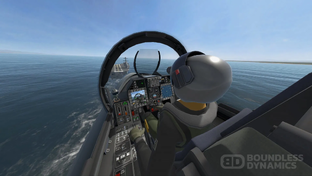Carrier Takeoff and Landing
This article offers a guide on how to properly take off from and land on naval carriers. It is designed with the F/A-26B in mind, but its principles can apply to other playable aircraft as well.
Introduction
There are two different types of carriers available to the playable faction in VTOL VR:
- The Aircraft Carrier - a typical aircraft carrier.
- The Assault Carrier - a smaller carrier intended for use with VTOL/STOVL aircraft like the F-45A and the AV-42C.
All playable aircraft in-game aside from the AH-94 support carrier operations. The F/A-26B is the primary carrier-based aircraft due to its lack of VTOL functionality. VTOL VR models many aspects of carrier landings, such as wind and hook physics. As such, real-world patterns and techniques should generally be applied here. This page will go through those techniques in detail, and explain how they pertain to VTOL VR.
Carrier Takeoff
Preface
Most aircraft, such as the F/A-26B, T-55 and EF-24G have a dedicated CATO TRIM (Catapult Trim) switch on the flight assist panel that trims the rear stabilizers up by ~20°. Activation of the CATO TRIM is not required, but is highly recommended to simplify takeoffs and ensure safe rotation. The AV-42C and F-45A have an automatic CATO TRIM.
Checklist
The Aircraft Carrier has 4 catapults, numbered 1–4. Catapults 1 and 2 are most commonly used, as they are not on the landing runway; this permits simultaneous takeoffs/landings. When requesting takeoff from ATC, the controller will assign you a "cat", or catapult. Taxi to your assigned catapult, then follow this checklist:
- Set Launch Bar DOWN.
- Line up the aircraft (forward-nosecone indicator on the HUD) with catapult and connect by rolling over the hub.
- When hooked in, set Wing Fold DOWN.
- Set Flaps 1.
- If applicable, set CATO TRIM ON (located in the Flight Assist Panel).
- Release stick, grip right handlebar.
- Throttle up to afterburner.
- After launch, retract your landing gear and launch bar, wait 3 seconds, set CATO TRIM OFF, set flaps to 0, and regain control.
Carrier Landing
Preface
Carrier landing is generally a very difficult task for many pilots. Unlike landing on an airport's runway, landing on a carrier is more about precision than anything else. It is generally a good idea to learn how to make minimal corrections to your flight path and start your maneuvers as early on as possible. Most importantly, practice is key. It takes time to develop a good technique for making smooth carrier landings. The checklist below serves as a baseline for stable carrier approaches.
Carrier Landing Checklist
- Fly past the starboard side of the carrier.
- At 800 ft, Set your Tailhook DOWN.
- Lower your Landing Gear and slow your aircraft to 250KIAS (use your airbrakes if needed).
- Set Flaps to mode 2.
- Descend to 600 ft.
- Contact Tower for landing clearance and Information
- Turn to Intercept the Glideslope.
- Slow to where your Angle of Attack (AoA) is at 8 degrees (adjust power accordingly).
- At ¾ miles, the LSO will call out "[CALLSIGN], Call the Ball."
- Follow the “Meatball” on the HUD to landing: If the Light is low, so are you. If the Light is high, so are you. Try to keep the Ball in the center. (BALL WILL INCREASE BRIGHTNESS WHEN CENTERED)
- In the final stages of the approach, follow LSO's guidance as closely as possible. Mind you do not overcorrect with your maneuvers here.
- Maintain an AoA of 8. Do NOT Flare. Fly the aircraft onto the runway and make contact with the arrestor cables.
- Upon Contact, Advance Throttle to Afterburner in case you miss the wires to avoid stalling.
- (If Wire Caught) Hold Afterburner for 4 seconds. Set Throttle IDLE. Set Hook UP, Set Wings UP, Set Flaps 0, Taxi to Parking Area
- (If Wire Missed) Bolter! Monitor Fuel Levels.
LSO Guidance
The LSO (Landing Signal Officer), upon you entering the "groove", or the final approach to the carrier, will call out "call the ball". Your response format is - “[CALLSIGN], Ball.” For example:
- LSO - “Kilo 1-1, call the ball.”
- Pilot - “Kilo 1-1, Wasp Ball”
After calling the ball, the LSO will give guidance down from ¾ miles. If Clara Ball has been called, it will begin immediately. Responding to the LSO is not strictly required for landing; if no response is given, then the LSO will start guiding you in at ¾ miles.
The LSO's commands are as follows:
- "Come left" - turn slightly left
- "Right for lineup" - turn slightly right
- "Power" - climb slightly, add some power to compensate for the resulting loss of airspeed
- "You’re high" - descend slightly, reduce power to compensate
- "Wave off!" - Pull up and break off. Re-enter the left-hand pattern.
- "Bolter!" - You've touched the deck but missed the wires - go around and try again!

